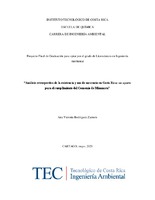Análisis retrospectivo de la existencia y uso de mercurio en Costa Rica: un aporte para el cumplimiento del Convenio de Minamata
Abstract
Los efectos nocivos para la salud originados por la distribución global del mercurio son ampliamente conocidos. Reconociendo esta situación, los países miembros de la Organización de Naciones Unidas, suscribieron el Convenio de Minamata sobre Mercurio. Este convenio establece medidas para mitigar la incorporación y redistribución del mercurio. Existen estudios con proyecciones al año 2050 que describen escenarios pesimistas frente a la distribución de este contaminante si no se toman medidas. Estas proyecciones han sido formuladas sobre estimaciones por el uso de materias primas o la producción industrial en donde se utiliza mercurio directamente o bien en los residuos generados. Existe un apartado del Convenio que establece las disposiciones para el control de liberaciones al agua y al suelo. Entre las fuentes de liberaciones se podrían considerar sitios con acumulación de mercurio que han pasado desapercibidos porque los esfuerzos han estado orientados hacia el inventario de existencias y procesos en el presente, o en la formulación de las proyecciones a futuro. Hay interés por identificar el origen de esta acumulación en sitios específicos por medio del desarrollo de un análisis histórico. Costa Rica es parte de los países que se comprometieron a proteger la salud humana de esta amenaza con su firma en el Convenio. Este trabajo busca como objetivo principal realizar una reconstrucción histórica de las liberaciones aproximadas de mercurio a partir de registros disponibles en el país. Concluyendo principalmente que, en la historia del país existieron dos principales usos del mercurio: en la minería de oro y en la iluminación pública. La minería resultó tener impactos significativos en la liberación de mercurio en el país. Se cuantificaron teóricamente más de 145 toneladas de mercurio liberados gracias a esta actividad dada en la antigüedad en Costa Rica. The harmful health effects caused by the global distribution of mercury are widely known. Recognizing this situation, the United Nations and its parties, signed the Minamata Convention on Mercury. This agreement establishes measures to mitigate the incorporation and redistribution of mercury. There are studies with projections to the year 2050 that describe pessimistic scenarios regarding the distribution of this pollutant if no measures are taken. These projections have been formulated based on estimates for the use of raw materials or industrial production where mercury is used directly or in the waste generated. There is a section of the Convention that establishes the provisions for the control of releases to water and soil. There are sites with accumulation of mercury that have gone unnoticed because efforts have been oriented towards the inventory of existence and processes in the present, or in the formulation of future projections. These sites can be considered among the sources of releases to water and soil. There is interest in identifying the origin of this accumulation in specific places through the development of a historical analysis. Costa Rica is one of the countries that pledged to protect human health from this threat by signing the Convention. The main objective of this work is to carry out a historical reconstruction of the approximate releases of mercury from records available in the country. Mainly concluding that, in the history of the country, there were two main uses of mercury: in gold mining and in public lighting. Mining turned out to have significant impacts on the release of mercury in the country. Theoretically, more than 145 tons of mercury released due to this ancient activity in Costa Rica were quantified.
Description
Proyecto de Graduación (Licenciatura en Ingeniería Ambiental) Instituto Tecnológico de Costa Rica, Escuela de Química, 2021 Esta tesis cumple con el Objetivo ODS 3: de la Agenda 2030 “ASEGURAR UNA VIDA SANA Y PROMOVER EL BIENESTAR DE TODAS LAS PERSONAS EN TODAS LAS EDADES" con la meta número 9: "Reducir considerablemente el número de muertes y enfermedades producidas por productos químicos peligrosos y la contaminación del aire, el agua y el suelo."


